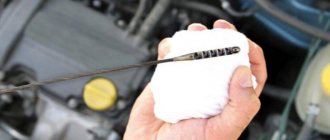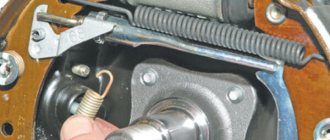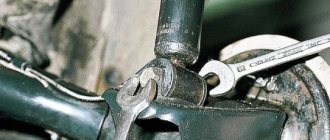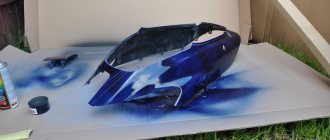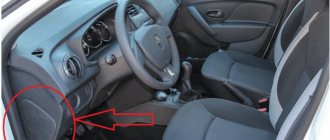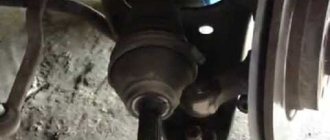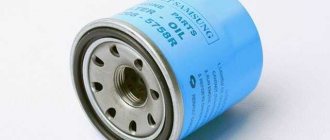Vehicle owners often face the problem of various types of damage occurring on the plastic inside the car. Often, such scratches do not affect the operation of the car in any way and do not require repair work, but they still spoil the overall appearance, which is unpleasant for every driver.
There are several ways to get rid of the problem using mechanical, chemical and thermal treatment. When deciding how best to remove scratches on plastic that have appeared inside a car, you should take into account the nature of the damage - the depth of the scratches, their “clustering”, the quality of the plastic itself and the surface texture of the polymer panels.
Removing scratches with wiping towels
Ways to eliminate flaws:
- Lighter.
- Construction hairdryer.
- Wax pencils.
- Polishing.
- The overhaul is carried out in a professional workshop, the plastic is cleaned, primed, painted, and varnished.
External defects can be removed using a lighter; turbocharged products with high temperatures and stable combustion are best suited. The problem area is heating up, you can’t keep the fire in one area, the hand with the lighter is constantly moving.
The flame is not brought too close; a suitable distance is selected so that the part does not melt. The abrasions will heal slowly; in a heated area, the soft plastic should not be touched with your hands. This method is suitable for smooth plastic; the structure of the corrugated surface changes after heating. Instead of a lighter, you can use a hair dryer that generates high heat. Sometimes the power of the device is enough to dry your hair. Before use, remove dirt, dust, and allow automotive cleaning chemicals or dishwashing detergent.
The hair dryer is turned on at a low temperature; if deformation does not occur, the power increases. Small damages are reduced immediately and polished for a better appearance. Microfiber cleaning towels are sometimes used. This is an effective method, the problem area is actively rubbed, all minor defects are eliminated. Dirty rags are washed and reused many times.
Minor defects appear on the panels inside the machine. If they are not restored in time, abrasions will appear everywhere, creating a cobweb that will be more difficult to deal with. You have to go to a workshop; it’s difficult to get rid of the problem on your own.
Types of Damage
We remove chips and scratches on paintwork.
Small scratches are often found inside the car, intertwining into a web of damage. As a result, the appearance of the interior is spoiled, which requires the search for camouflage techniques. Knowing your options, you can remove defects in a short time with minimal financial costs.
More serious costs will be incurred if you have to repair deep damage, since many defects cannot be hidden using simple techniques. The following are the most common methods that will help remove unwanted scratches, thereby improving the appearance of your car's interior.
There are several options for scratching plastic in the car interior:
- Small cracks in the car formed when the material comes into contact with the driver’s keys and other personal belongings that come into contact with the panel.
- Deep large cracks that require a more detailed approach to their destruction.
- Scratches caused by the sun as a result of its action. The fact is that after radiation the surface becomes dull and loses its color.
The removal process is not always simple; major repairs of the products will be required.
Professional approach
To eliminate really serious damage to plastic in the interior or outside of the car, sometimes it is worth using the help of specialized specialists.
But there are situations that can be easily fixed. In this case, there are no special tools and devices that cannot be found at home or in the garage that you do not need to use.
As practice shows, experts in removing defects on the plastic surfaces of a car work mainly with the help of hair dryers, lighters and pencils. It is worth knowing that in which hair dryer or which lighter you will have to make scratches on the dashboard or magically disappear the dashboard. In fact, These are professional methods because they can be used alone, in regular garage conditions.
How to remove scratches on interior plastic 4 methods to choose from
Renault Logan Silver Logbook 016 Replacing the air filter. TO1-1
- Minor scratches. Most often, they form a whole web, since they arise in places that are constantly exposed to the same type of influence. They will be the easiest to deal with, despite their abundance;
- Deep scratches or cuts. They can be found anywhere, as they are the result of rough physical contact with something sharp, but most often they appear on door trims as a result of loading a large item. They can be removed, although in more complex ways than defects of group 1;
- A combination of types 1 and 2 damage with the consequences of exposure to ultraviolet radiation. Naturally, the dashboard burns out. In combination with even minor scratches, the appearance is terrible and cannot be removed with home remedies.
- The area to be repaired is washed and dried;
- The hair dryer is turned on to minimum and directed towards the defect. There is no need to hold it at one point - move along the damage not quickly, but not too slowly.
- The surface is cleaned again with water and detergent and dried - dirt that has accumulated in the defects will not allow them to heal well;
- The paste is applied to the damage using a soft dishwasher or foam rubber;
- Wait the time indicated on the package - usually about 5 minutes. The signal that you are ready for polishing will be the formation of a whitish coating;
- It is better to polish by hand: there are not many plastic surfaces in the interior, and the strong heat of a sander can damage them beyond repair.
AutoFlit.ru
Traditional methods of getting rid of scratches
You can remove scratches from the plastic display of your phone using folk remedies, such as toothpaste. Clean the surface of the object, rub toothpaste into the scratch in a circular motion and leave for 2-3 minutes. Then wipe off the excess with a soft cloth. The method is used for plastic phone screens and gadget cases.
The abrasive parts of baking soda work similarly to toothpaste—filling cracks and smoothing the surface—but baking soda can only be used on hard plastic. Mix baking soda with water in a 1:2 ratio and rub into the scratch in a circular motion. Then polish the surface with a soft cloth.
Toothpaste and baking soda are not suitable for removing deep scratches.
How to remove a small scratch from plastic
Polishing plastic from scratches
The first two methods are suitable for very minor damage. In the first case, the surface is heated. Using a hairdryer is, of course, safer. An open flame near plastic creates the preconditions for a fire. A hairdryer can be both household and construction. You should not direct the hot jet to one place; you need to heat the entire surface very gradually so as not to melt the part.
If you decide to use a lighter, you need to purchase a so-called turbo lighter. It is easily identified by the blue color of the flame. It's best to first practice on some plastic object that you don't mind throwing away
Act quickly and carefully, don't burn a hole
The method is based on the ability of heated plastic to soften and heal minor damage. Never touch hot material unless you want to leave fingerprints or completely deform the part. Such damage cannot be repaired.
The second method is reminiscent of regular kitchen cleaning. Special towels and napkins are made from polymer microfiber. This type of fabric is called microfiber and is used in a variety of cleaning products. Your favorite car is no different from a kitchen item. Any car owner who wants to keep their car clean should have a set of towels. Then, no matter where you are, you will have the opportunity to remove a dirty or greasy stain. If you find minor damage to the inner surface of the car, just rub it vigorously for two to three minutes.
Now you know how to remove a scratch from the plastic of a car interior if it is a microdefect. But what to do when the flaw is serious?
Polishing car interior plastic from scratches
If you find a deep enough mark from your keys or another metal object, you need an anti-scratch car interior plastic polish. There are a variety of products available on the market and they are used in different ways. There are supporters of grinding machines. Other experts believe that plastic can only be processed by hand. Whatever you choose, the sequence of actions is standard.
They start working with compounds with larger abrasive grains and end up with “velvet” ones. At the end - a restorative paste. Polishes not only restore the appearance of parts, they can protect against fading under the influence of the sun and provide an antistatic effect.
How to repair scratches on plastic in the interior quickly and reliably? Try a wax pencil. Keep in mind that a quality product will be quite expensive, but you can keep it for the future and use it again. Basically, it's not even a pencil. This is a small bottle filled with the appropriate substance.
Your actions are completely primitive: use a sharp end to shade the damaged area, wait for the composition to harden, and polish. Of course, the result will not always satisfy you. It is often not possible to find a pencil of the appropriate color. In addition, the damage does not disappear, but is masked. But for some time the plastic panel will look quite decent. When the opportunity arises, you can contact a specialist or deal with the problem yourself.
Alternative methods
Craftsmen offer a variety of ways to “cure” plastic.
- GOI paste, which is used for polishing jewelry. Apply a little paste to a soft cloth, then wipe the damaged surface until it is in satisfactory condition. At the end, rinse the part thoroughly to remove any remaining paste;
- Another rather exotic method is the restoration of plastic with plastic. To do this, you need to melt a little plastic, then dissolve it in white spirit, rub the resulting composition into the damaged area. After the mixture has hardened, polish the part.
You can choose a very reliable, but difficult technique - to paint whatever you want. This is expensive and difficult, but this way all defects will disappear. Consult a specialist, assess your abilities and financial capabilities. If you're willing to take the risk, be prepared for long, hard work, but when you're done, you'll feel like a jack of all trades.
What methods of removing scratches do you know? Share your knowledge in! And also watch a video about restoring plastic inside a car.
How to get rid of deep marks
You can remove deep marks using sandpaper or a special product. Sandpaper is suitable for sanding and polishing scratches, but should not be used on glossy plastic surfaces. Matte plastic of window sills and car interiors must be handled carefully.
Before starting treatment, wipe the item with alcohol. To get rid of a crack, take 800-grit sandpaper and sand the scratch in a circular motion until the defect disappears. Then wipe with a damp and dry cloth.
You can use Displex scratch remover paste. The product removes large and deep scratches: it contains plastic microparticles that will fill the damage. Apply the paste to a cotton pad and rub into the damaged area for 2-3 minutes. If the crack does not disappear, repeat. Then remove any excess Displex and wipe the plastic with a dry cloth.
Liquid plastic can help repair heavily damaged surfaces, but it must be identical to the base material of the surface. Gently rub the liquid plastic into the scratch and let it harden. Then apply polish.
What can cause scratches in a car?
Every car owner with at least one child in the family knows firsthand what scratches are. Unfortunately, this is a common thing when a child, having nothing better to do, starts scratching the plastic on the car doors during a trip. You can often find scratches on the bottom of the doors, this is also the fault of the kids, they like to hit the door with their feet, perhaps this happens involuntarily, but, alas, this can happen to anyone. Of course, adults can also inadvertently damage the plastic coating on the doors inside the car; this can be done with shoes or ignition keys.
We will outline the most common reasons why scratches occur inside a car:
- Transporting animals (frightened dogs or cats may start scratching at doors with their claws).
- Transportation of large items inside the cabin.
- Children's pranks.
- Damage to plastic from shoes.
- Damage to material from keys.
Means for removing minor scratches
Small scratches can also be treated with a colorless product. A striking example of this is “Disc Repair”, or “Displex”. However, you can also take car body polish. These polishes can be both coarse, that is, abrasive, and finishing, that is, soft silicone. But for plastic, only soft polish will be used.
How to remove scratches
How to apply products to a damaged surface?
All products should be applied to the surface of plastic parts only with a soft, preferably flannel, cloth or napkin. It is optimal for these purposes to take a regular baby diaper.
Why does plastic get damaged?
Plastic is an inexpensive material, which is why it is preferred to be used in car interior decoration. And the more budget the car, the more plastic and the lower its quality.
There are many reasons why plastic interior parts may suffer:
- natural wear and tear;
- manufacturing defects;
- sloppy movements;
- luggage transportation;
- accidental impacts;
- air temperature;
- high or low humidity;
- exposure to direct sunlight;
- sudden temperature changes, etc.
Since there is no additional protective coating for plastic, sometimes a minor impact is enough for a chip or scratch to appear.
Using polishes and gels
If microfiber does not give results, gels and polishes are used. The composition is applied to cotton wool; when rubbed, fragments of the gel fall into the recesses and cover them. After 30-50 minutes the polish will harden. Use abrasive pastes, a grinding machine or a rag.
Instructions:
- Apply a thin layer of polish to a clean area and rub it with felt.
- After the appearance of a light gray layer, polishing is performed until the abrasions disappear.
- You can’t wait too long; the dry mixture doesn’t grind well.
- The panels are sanded to a shine.
- The remaining polish is removed and the plastic is washed.
The glossy and transparent coating quickly becomes scuffed.
Adviсe
Industrial pencils, abrasive gels, and polishing pastes effectively remove defects from plastic, but they are quite expensive.
Available tools that can be found in the arsenal of any housewife will come to the rescue:
Toothpaste .
The method is suitable for cleaning plastic screens and displays. Apply a small amount of product to the damaged surface and rub in in a circular motion. When the surface dries, the residue should be washed off with a damp cotton swab.- Vegetable oil . The liquid masks minor scratches and adds shine to the plastic. Apply 3-5 drops to the damaged surface and polish until the characteristic greasy drops disappear.
- Baking soda . The abrasive acts like toothpaste. Add water to the powder until it reaches a paste consistency, rub into the surface, and rinse off any remaining residue.
The methods are not suitable for eliminating deep traces of mechanical damage.
If you are interested in how to remove small and deep scratches from various surfaces and objects, take a look at this section.
Wax pencils for removing scratches from plastic in the interior
The painted material will not be restored with gel if the scratch is deep; wax pencils of different colors are used. First, the coating is degreased, the abrasion is removed, and the wax quickly fills the gap.
Types of damage:
- Small ones appear most often and are easily and cheaply removed.
- Deep ones are more difficult to repair; there is no need to replace parts.
- Deformation caused by ultraviolet radiation is more difficult to correct; you have to take the car to a workshop.
Often several flaws of varying depths appear in one area, and major repairs have to be carried out.
Car owners try to improve their appearance on their own, but they do not always manage to do it correctly. You have to pay a lot of money at the service station so as not to damage the car even more. There are hundreds of poker rooms on the Internet, which differ in the choice of entertainment, the level of players and limits. PokerDom is one of the best services in demand among clients. With it, anyone can become a poker professional without the risk of losing money.
Instructions:
- The scratched cover is removed.
- Dirt is removed.
- The problem area is primed.
- The part is sanded, painted, and dried before processing.
- The coating is varnished.
- Polishing gives the product shine.
Some flaws are difficult to repair; all the linings have to be repainted the same color.
Car enthusiasts' opinion:
- There is no point in repainting or changing the door card due to minor defects.
- A construction hairdryer can damage fusible material.
- Sandpaper leaves new abrasions.
- You cannot cover them with stickers.
- Not all workshops carry out such restoration.
Features of hand polishing:
- Suitable for small items and small areas.
- You will need a homogeneous paste without impurities.
- The oil gives a glossy shine.
- The abrasive is applied with felt or felt in a circular motion without pressure.
- Treatment lasts 15-20 minutes.
https://youtube.com/watch?v=G19J6sA6h84
X
Surface restoration compounds and tools
Scratches can be removed using both special compounds and available household products.
For the restoration of plastic products the following can be used:
- polishing paste;
- clear nail polish;
- furniture varnish;
- toothpaste;
- car wax;
- coloring pencil;
- special polishes;
- baking soda.
To clean from contamination you will need a soap solution and a clean rag. Degreasing is carried out with alcohol, white spirit, gasoline, acetone. To sand a damaged plastic element, you will need sandpaper of different grain sizes, an electric drill, and a polishing sponge. A hair dryer and lighter will help soften the material.
What to do if the scratches on the plastic are very deep
Previously, we described the most popular options for removing damage to plastic. But what if they are very deep, then how to remove scratches on the plastic in the car? There is no need to despair, there is also an effective solution to this problem; of course, it will require more effort from the car owner, but if used correctly, the result will exceed all expectations!
You will need a small piece of plastic, the color palette matching the part of the surface being repaired. It is recommended to take the material from the inside of the plastic, for example from the partition. These actions will not cause any harm to the design of the parts.
Dichloroethane can be purchased in this format.
The plastic must be dissolved in a substance such as dichloroethane. Apply the resulting consistency evenly to the damaged areas. While the surface being treated has not completely hardened, it can be made into any desired shape.
Polishing plastic parts cannot completely hide scratches; it can only refresh their appearance. It is completely inappropriate on a rough or matte surface.
Door thresholds are also not suitable for polishing; they cannot be repaired at all; it is easier to replace them with other parts.
Leveling large scratches:
- a compound must be applied to the damaged area, which, if used correctly, should completely fill the scratch. It is selected according to the type and general properties of the material being repaired;
- the damaged area is rubbed very carefully;
- then a textured pattern is applied to the entire surface of the part being repaired. To do this, the surface is coated with a special plasticizer gel. And after it has completely hardened, the gel is removed, and only the resulting pattern remains;
- Next, tinting and painting are performed.
Removing flaws on the plastic in a car is a rather labor-intensive process. If you are not confident in your abilities, use the services of a service station.
Overhaul of plastic
It is not always possible to repair the plastic inside a car using simple means. Chips, cracks, burnt spots of paint - all this requires careful repair of the plastic parts of the car dashboard. Repairs are carried out as follows:
- The damaged part is disassembled.
- It is thoroughly cleaned of dirt, degreased and polished.
- We seal cracks and chips with a primer.
- The surface is polished.
- Paint the surface and let it dry.
- Varnishing with several layers of varnish.
- Polish to a high gloss finish.
Options
Based on the type of plastic that covers the panel, as well as the type of damage present on the surface, you can choose a specific method by which the repair will be carried out. For this, improvised devices such as a hair dryer, open fire, polishing, pencils, and stripping are used. Let's look at each of the options in more detail.
Using a hair dryer
A hair dryer is a proven tool for cars aimed at removing damage. You can use not only a special tool, but also an ordinary household hair dryer. Restoration is quite simple: in the car, prolonged damage becomes invisible.
To repair a torpedo using this method, it is necessary to prepare the surface by washing it, which will allow the scratches to be freed from ingrained dirt. After going through the drying stage, you need to polish the damaged area with an air flow.
Using a lighter
Open fire is the best plastic reducer in a car. Operations using a lighter are a proven process that does not require a lot of time and money. To remove defects, you need to bring the lighter to the plastic surface and run the flame along the scratch several times.
Polishing the material
If your car has scratches, it is not necessary to carry out expensive repairs (polishing); perhaps a polishing procedure will do. To ensure high quality polishing, an abrasive paste is used. Varnish and paint products are contraindicated. Simple polishing involves a set of steps:
- the surface is washed away from dirt;
- the treated area must be dried and cooled in a room without light;
- apply a special paste to the panel manually;
- Polishing begins directly.
Thus, polishing is a proven method for eliminating problems with the interior of a car.
Using special pencils
Special pencils for plastic are often used for instrument panels and instruments to remove problems. This method is not one of the most budget-friendly options, since markers are expensive. They are presented in bottles with a mixture that, when applied to the damaged area, will fill the groove of the scratch and eliminate it. An important role is played by the choice of color in accordance with the tone of the panel.
Rating of restorers for plastic
Based on reviews and tests found on the Internet, a non-advertising (!!!) rating of plastic car restorers was compiled. The products listed in it do an excellent job of restoring plastic, so they are recommended for purchase. Which one to choose is up to the car enthusiast to decide.
Doctor Wax Plastic Restore & Shine
Doctor Wax Plastic Restore & Shine is a plastic restorer, shine and protection. It is a liquid applied to the surface with microfiber. A special feature of the packaging is the presence of a special plastic bag for storage, as well as the presence of a round microfiber pad for application. The bottle is convenient to store in the packaging, and the fiber does not absorb much of the restorer. The product can be used to treat external and external plastic parts of the machine. After application, a layer of polymer remains on the surface. Thanks to this, the parts acquire dirt- and water-repellent properties, prevent plastic from cracking under the rays of the sun, and acquire antistatic properties. The plastic becomes beautifully matte.
A special feature of application is that the bottle must be shaken beforehand. Apply to a clean, dry surface and polish for 3…5 minutes. There are many positive reviews and even video reports on the Internet about the use of the Doctor Vax plastic restorer. It is noted that it has proven itself well when processing worn dashboards, door armrests and other interior parts. The same goes for external parts. The average validity period is about one and a half months. The only disadvantage we can note is the relatively high price compared to analogues.
The volume of the product in the bottle produced by the manufacturer is 300 ml. You can buy one package in the online store using the article number - DW5219. Its average price for the same period is about 550 rubles.
1
Lavr Polish & Restore Anti-Skratch E
A product called Lavr Polish & Restore Anti-Skratch E is officially called by the manufacturer as a professional formula restorer polish. Can be used to process both internal and external plastic parts of the car. Has no smell. It has a liquid state of aggregation and is applied using a rag or microfiber. Excellent for erasing scratches and damage on plastic surfaces. At the same time, the treated surface has a beautiful matte shine. Safe for any materials, oil-based. It has a moisture-repellent and antistatic effect.
On the Internet you can find a lot of positive reviews and tests of the plastic restorer for cars “Lavr”. Often it is used to treat not only damaged, but also ordinary surfaces to give them shine. Especially for old plastic parts where there are many small cracks (for example, the dashboard of old cars). Separately, it is worth noting the relatively low price of the product. Judging by the reviews, the average period for which the restorer lasts is one month. Among the shortcomings, one can only note the fact that the Lavr restorer does not cope very well with really large scratches.
Sold in plastic bottles of two sizes - 120 and 310 ml. To make a purchase, it makes sense to use the catalog number. The part number for the smaller can is LN1459L and the part number for the larger can is LN1460L. The average price of one small bottle in online stores as of the summer of 2022 is about 200 Russian rubles, and a large bottle is about 360 rubles.
2
VMPAauto
Domestic restorer-cleaner for plastic from the VMPAauto company - Waxis Professional 7303. Designed for processing plastic and various polymer surfaces. Absolutely harmless to them. A special feature of the packaging is that it is sold in a bottle with a manual trigger sprayer. This means that the consumption will be less, since it will not absorb into the fiber. Otherwise, it has traditional properties - it restores plastic, gives it a matte shine, antistatic and water-repellent properties, protects plastic from further cracking, restores color (the restorer itself is colorless, so it can be used for surfaces of any color). Please note that it can only be used to process interior elements (in particular, the dashboard). After application, the product should be polished with a soft cloth or sponge.
There are few reviews about it on the Internet, but those that were found indicate that the restorer from VMPAavto has average performance characteristics. That is, with its help you can mask minor scuffs and scratches for a while. The “trick” of the packaging is the fact that there is a special Velcro on the body of the restorer, which, according to the manufacturers, is designed to allow the user to secure the bottle in any position, even on a fleecy surface. The advisability of this approach is up to the car owner to judge. The advantage is the low price.
The volume of the bottle is 350 ml. The price of one package is about 250 rubles.
3
SONAX Kunststoff Neu Schwarz
SONAX Kunststoff Neu Schwarz 409100 is positioned by the manufacturer as a restorer for black plastic. In particular, both for restoring black color and minor scratches and abrasions. Can be used for both interior and exterior plastic parts of the car. Designed, among other things, to protect plastic parts from exposure to ultraviolet radiation, including restoring already faded color. The validity period of the Sonax restorer is two to three months, provided there are no mechanical impacts on the part. Apply to the surface to be treated using the applicator built into the bottle.
A special feature of the application is that it is recommended to wet the cloth before polishing the applied product. The restorer must be applied to a clean and preferably degreased surface. It is recommended to rinse the applicator with water after use.
As for the reviews found on the Internet, they are mostly positive. The restorer is really good at restoring the black color of plastic and it remains for a long time. As for the mechanical recovery, it is not up to par. Therefore, SONAX Kunststoff Neu Schwarz is best used as a color restorer. The disadvantage is the relatively high price of the product.
It is sold in a 100 ml bottle. It can be bought in an online store for about 1000 rubles.
4
Rinkai
The Rinkai RC1202 restorer polish is a universal product and can be used both for processing plastic car parts and at home. In particular, it can be used on plastic, leather and vinyl. It is indicated that the Rinkai plastic restorer can be used to process both internal and external parts of the car. The action of the product is standard - it protects the plastic from cracking, masks scratches, displaces moisture, and gives a beautiful matte shine.
It is sold in an aerosol can, that is, it is convenient to use for application to large areas. Composition - Petroleum ether more than 30%, polydimethylsiloxane 5...15%, white mineral oil 5...15%, flavor less than 5%, liquefied gas 15...30%. Does not contain ozone-depleting components.
There are few reviews on the Internet about the product, but sellers assure that this restorer is a good universal tool with which you can both restore car parts and use it in everyday life. Therefore, his performance is average. But the advantage lies in versatility.
The restorer is sold in an 840 ml aerosol can. The article number by which it can be purchased in the online store is RC1205. The approximate price of one package is 500 rubles.
5
How to remove scratches from a car interior
- If the scratch has protruding edges, they must be removed using fine-grain sandpaper (400–600). Small scratches can be smoothed out with a finer abrasive (800-1000). When sanding, do not remove too much of the texture of the plastic. Sanding will smooth out the roughness, and further heating will remove the dullness. You can also carefully cut off the raised areas using a blade. In most cases, small raised areas can be removed with a fingernail. Even if you don’t polish the scratches first, you will still get a positive result if you apply the heat correctly.
- Clean the plastic from dirt, dust and protective coatings. To do this, you can use a soap solution, and for degreasing, isopropyl alcohol.
- Next, wipe the surface dry.
- Using a hair dryer, heat the surface until the plastic shines a little. The hair dryer is usually set to half power. Here you need to be careful not to overheat the plastic part. It is better to first practice on an unnecessary plastic panel or in a hidden place. With the help of heat, minor scratches and abrasions will begin to disappear. The surface begins to melt and small scratches are smoothed out. At the same time, if the hair dryer is used correctly, the surface texture is not damaged. When the plastic is heated, it should not be touched, as imprints will immediately appear, which will remain after the plastic cools. A hair dryer may not be enough. Heating to a temperature of about 200 degrees will not give the desired result. In addition, a hair dryer does not provide focused heat. You must use a hair dryer designed for technical purposes.
- To prevent plastic from fading when exposed to sunlight, you need to use special protective compounds for the interior with protection from ultraviolet rays.
Heating removes scuff marks and dullness.
Note: When using a hair dryer, do not bring it too close or hold it in one place for too long. This may melt the plastic too much and damage it, or it may leave shiny spots. The idea is to constantly move the hair dryer with a small, uniform amplitude. You can do circular movements. You need to move slowly, at a constant low speed, so as not to form streaks. You need to heat in small sections at a time.
The air needs to be set to low speed. Heating does not remove scratches, but it does smooth out their edges. As a result, scratches become less noticeable.
The same method can be used to renew the surface of unpainted plastic bumpers. If after such a procedure you do not protect the bumper with a special anti-fading agent, the result will not last too long.

